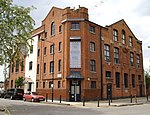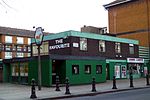Lancaster West Estate

Lancaster Road (West) Estate is a housing estate in North Kensington, west London. It is in an area known as Notting Dale which experienced V-2 bombing during the Second World War. It was built as municipal housing as part of the slum clearances of the 1960s.The estate was designed in 1963-4 as part of a major Royal Borough of Kensington and Chelsea redevelopment scheme designed by architects Clifford Wearden and Peter Deakins but was later much modified and reduced in scale and ambition. It is immediately east of Latimer Road tube station. It opened in the mid 1970s, and was composed of one tower block (Grenfell Tower) of 23 stories and 900 other units. In the early hours of 14 June 2017, the Grenfell Tower caught fire, resulting in large loss of life.
Excerpt from the Wikipedia article Lancaster West Estate (License: CC BY-SA 3.0, Authors, Images).Lancaster West Estate
Whitchurch Road, London North Kensington (Royal Borough of Kensington and Chelsea)
Geographical coordinates (GPS) Address Nearby Places Show on map
Geographical coordinates (GPS)
| Latitude | Longitude |
|---|---|
| N 51.513187 ° | E -0.216466 ° |
Address
Whitchurch Road
W11 4AS London, North Kensington (Royal Borough of Kensington and Chelsea)
England, United Kingdom
Open on Google Maps







